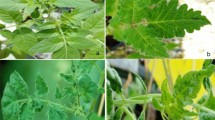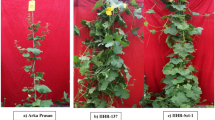Abstract
Tomato spotted wilt virus (TSWV) resistance wasidentified in Y118 (Fla 925-2), an F1BC1S6 tomato line(Lycopersicon esculentum Mill.), derived from a crosswith L. chilense Dun. (LA 1938). This line waspreviously selected for tomato mottle virus (ToMoV)resistance in Florida. Progeny from crosses betweenFla 925-2 and three different TSWV susceptible L.esculentum parents were used in TSWV resistancestudies. A total of 75 F1 and 596 F2 plants from allthree crosses were screened for TSWV resistance. ForF2 plants free of TSWV symptoms, evaluations were madeusing enzyme-linked immunosorbent assay (ELISA). TenF3 populations used for further greenhouse and fieldscreenings were selected from F2 plants found to befree of the virus using visual and ELISA criteria ateach evaluation. One F1 and four F3 lines werestudied under field conditions (Stellenbosch, SouthAfrica) in which 100% of the `Flora-Dade' susceptiblecontrols were severely infected with TSWV. Theresults of the field study clearly establish that TSWVfield resistance is present in the Fla 925-2 (Y118)derived lines. Studies conducted on these linesrevealed that this resistance has the distinctcharacteristic of often `recovering' from initiallyhigh levels of virus titer in the tissue to levelsbelow detection with ELISA.
Similar content being viewed by others
References
Ben-Ari, E., 1999. The silence of the genes. BioSci 49: 432-436.
Benhamou, N. & N. Nicole, 1999. Cell biology of plant immunization against microbial infection: The potential of induced resistance in controlling plant diseases. Plant Physiol Biochem 37: 703-719.
Boiteux, L.S. & L. de B. Giordano, 1993. Genetic basis of resistance against two Tospovirus species in tomato (Lycopersicon esculentum). Euphytica 71: 151-154.
Cho, J.J., R.F.L. Mau, T.L. German, R.W. Hartmann, L.S. Yudin, D. Gonsalves & R. Provvidenti, 1989. A multidisciplinary approach to management of tomato spotted wilt virus in Hawaii. Plant Dis 73: 375-383.
Iizuka, N., L.S. Boiteux, L.B. Giordano, T. Nagata & A.N. Dusi, 1993. Sources of resistance to spotted wilt virus (TSWV) in wild Lycopersicon species. Rep Tomato Genet Coop 43: 20-22.
Latham, L.J. & R.A.C. Jones, 1998. Selection of resistance breaking strains of tomato spotted wilt tospovirus. Ann Appl Biol 133: 385-402.
Maluf, W.R., M. Toma-Brahini & R.D. Corte, 1991. Progress in breeding tomatoes for resistance to tomato spotted wilt. Brazil J Genetics 14: 509-525.
Mumford, R.A., I. Barker & K.R. Wood, 1996. The biology of the tospoviruses. Ann Appl Biol 128: 159-183.
Pennazio, S., P. Roggero & M. Conti, 1999. Recovery of plants from viral diseases: historical and new perspectives. J Plant Dis Prot 106: 128-139.
Peters, D., 1998. An updated list of plant species susceptible to Tospoviruses, pp. 107-110. In: D. Peters & R. Goldbach (Eds.), Recent Progress in Tospovirus and Thrips Research. Abstracts of the Fourth International Symposium on Tospoviruses and Thrips in Floral and Vegetable Crops, 110 pp. Wageningen, The Netherlands.
Roselló, S., M.J. Díez & F. Nuez, 1998. Genetics of tomato spotted wilt virus resistance coming from Lycopersicon peruvianum. Eur J Plant Pathol 104: 499-509.
Scott, J.W., M.R. Stevens, J.H.M. Barten, C.R. Thome, J.E. Polston, D.J. Schuster & C.A. Serra, 1996. Introgression of resistance to whitefly-transmitted geminiviruses from Lycopersicon chilense to tomato. In: Gerling D. & R.T. Mayer (Eds.), Bemisia 1995: Taxonomy, Biology, Damage Control and Management. Intercept Ltd. Andover, Hants U.K. 30: 357-367.
Soler, S., M.J. Díez & F. Nuez, 1998. Apparent recovery in two Lycopersicon hirsutum accessions infected by tomato spotted wilt virus (TSWV). Rep Tomato Genet Coop 48: 46-47.
Stamova, L., 1996. Resistance to tomato spotted wilt virus. Rep Tomato Genet Coop 46: 24-25.
Stevens, M.R., S.J. Scott & R.C. Gergerich, 1992. Inheritance of a gene for resistance to tomato spotted wilt virus (TSWV) from Lycopersicon peruvianum Mill. Euphytica 59: 9-17.
Stevens, M.R., S.J. Scott & R.C. Gergerich, 1994. Evaluation of seven Lycopersicon species for resistance to tomato spotted wilt virus (TSWV). Euphytica 80: 79-84.
Thompson, G.J. & J.J.B. van Zijl, 1996. Control of tomato spotted wilt virus in tomatoes in South Africa. Acta Hort 431: 379-384.
van Zijl, J.J.B., S.E. Bosch & C.P.J. Coetzee, 1986. Breeding tomatoes for processing in South Africa. Acta Hort 194: 69-75.
Author information
Authors and Affiliations
Rights and permissions
About this article
Cite this article
Canady, M., Stevens, M., Barineau, M. et al. Tomato Spotted Wilt Virus (TSWV) resistance in tomato derived from Lycopersicon chilense Dun. LA 1938. Euphytica 117, 19–25 (2001). https://doi.org/10.1023/A:1004089504051
Issue Date:
DOI: https://doi.org/10.1023/A:1004089504051




